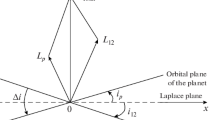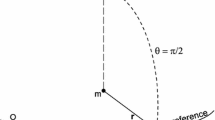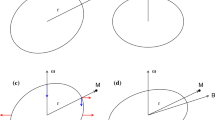Abstract
We investigate the secular dynamics of three-body circumbinary systems under the effect of tides. We use the octupolar non-restricted approximation for the orbital interactions, general relativity corrections, the quadrupolar approximation for the spins, and the viscous linear model for tides. We derive the averaged equations of motion in a simplified vectorial formalism, which is suitable to model the long-term evolution of a wide variety of circumbinary systems in very eccentric and inclined orbits. In particular, this vectorial approach can be used to derive constraints for tidal migration, capture in Cassini states, and stellar spin–orbit misalignment. We show that circumbinary planets with initial arbitrary orbital inclination can become coplanar through a secular resonance between the precession of the orbit and the precession of the spin of one of the stars. We also show that circumbinary systems for which the pericenter of the inner orbit is initially in libration present chaotic motion for the spins and for the eccentricity of the outer orbit. Because our model is valid for the non-restricted problem, it can also be applied to any three-body hierarchical system such as star–planet–satellite systems and triple stellar systems.


















Similar content being viewed by others
Notes
References
Alexander, M.E.: The weak friction approximation and tidal evolution in close binary systems. Astrophys. Space Sci. 23, 459–510 (1973). doi:10.1007/BF00645172
Beaugé, C., Nesvorný, D.: Multiple-planet scattering and the origin of hot Jupiters. Astrophys. J. 751, 119 (2012). doi:10.1088/0004-637X/751/2/119. arXiv:1110.4392
Bosanac, N., Howell, K.C., Fischbach, E.: Stability of orbits near large mass ratio binary systems. Celest. Mech. Dyn. Astron. 122, 27–52 (2015). doi:10.1007/s10569-015-9607-6
Boué, G., Fabrycky, D.C.: Compact planetary systems perturbed by an inclined companion. II. Stellar spin-orbit evolution. Astrophys. J. 789, 111 (2014). doi:10.1088/0004-637X/789/2/111. arXiv:1405.7636
Boué, G., Laskar, J.: Precession of a planet with a satellite. Icarus 185, 312–330 (2006). doi:10.1016/j.icarus.2006.07.019
Boué, G., Laskar, J.: Spin axis evolution of two interacting bodies. Icarus 201, 750–767 (2009). doi:10.1016/j.icarus.2009.02.001
Brozović, M., Showalter, M.R., Jacobson, R.A., Buie, M.W.: The orbits and masses of satellites of Pluto. Icarus 246, 317–329 (2015). doi:10.1016/j.icarus.2014.03.015
Colombo, G.: Cassini’s second and third laws. Astron. J. 71, 891–896 (1966)
Correia, A.C.M.: Secular evolution of a satellite by tidal effect: application to Triton. Astrophys. J. 704, L1–L4 (2009). doi:10.1088/0004-637X/704/1/L1. arXiv:0909.4210
Correia, A.C.M.: Stellar and planetary Cassini states. Astron. Astrophys. 582, A69 (2015). doi:10.1051/0004-6361/201525939
Correia, A.C.M.: Cassini states for black hole binaries. Mon. Not. R. Astron. Soc 457, L49–L53 (2016). doi:10.1093/mnrasl/slv198. arXiv:1511.01890
Correia, A.C.M., Laskar, J.: Tidal evolution of exoplanets. In: Exoplanets, University of Arizona Press, Tucson, pp. 534–575 (2010)
Correia, A.C.M., Laskar, J., Farago, F., Boué, G.: Tidal evolution of hierarchical and inclined systems. Celest. Mech. Dyn. Astron. 111, 105–130 (2011). doi:10.1007/s10569-011-9368-9. arXiv:1107.0736
Correia, A.C.M., Boué, G., Laskar, J.: Pumping the eccentricity of exoplanets by tidal effect. Astrophys. J. 744, L23 (2012). doi:10.1088/2041-8205/744/2/L23. arXiv:1111.5486
Correia, A.C.M., Boué, G., Laskar, J., Morais, M.H.M.: Tidal damping of the mutual inclination in hierarchical systems. Astron. Astrophys. 553, A39 (2013). doi:10.1051/0004-6361/201220482. arXiv:1303.0864
Correia, A.C.M., Boué, G., Laskar, J., Rodríguez, A.: Deformation and tidal evolution of close-in planets and satellites using a Maxwell viscoelastic rheology. Astron. Astrophys. 571, A50 (2014). doi:10.1051/0004-6361/201424211. arXiv:1411.1860
Correia, A.C.M., Leleu, A., Rambaux, N., Robutel, P.: Spin-orbit coupling and chaotic rotation for circumbinary bodies. Application to the small satellites of the Pluto–Charon system. Astron. Astrophys. 580, L14 (2015). doi:10.1051/0004-6361/201526800. arXiv:1506.06733
Couetdic, J., Laskar, J., Correia, A.C.M., Mayor, M., Udry, S.: Dynamical stability analysis of the HD 202206 system and constraints to the planetary orbits. Astron. Astrophys. 519, A10 (2010). doi:10.1051/0004-6361/200913635. arXiv:0911.1963
Doolin, S., Blundell, K.M.: The dynamics and stability of circumbinary orbits. Mon. Not. R. Astron. Soc. 418, 2656–2668 (2011). doi:10.1111/j.1365-2966.2011.19657.x. arXiv:1108.4144
Doyle, L.R., Carter, J.A., Fabrycky, D.C., Slawson, R.W., Howell, S.B., Winn, J.N., et al.: Kepler-16: a transiting circumbinary planet. Science 333, 1602 (2011). doi:10.1126/science.1210923. arXiv:1109.3432
Efroimsky, M., Williams, J.G.: Tidal torques: a critical review of some techniques. Celest. Mech. Dyn. Astron. 104, 257–289 (2009). doi:10.1007/s10569-009-9204-7. arXiv:0803.3299
Eggleton, P.P., Kiseleva-Eggleton, L.: Orbital evolution in binary and triple stars, with an application to SS Lacertae. Astrophys. J. 562, 1012–1030 (2001). doi:10.1086/323843. arXiv:astro-ph/0104126
Farago, F., Laskar, J.: High-inclination orbits in the secular quadrupolar three-body problem. Mon. Not. R. Astron. Soc. 401, 1189–1198 (2010). doi:10.1111/j.1365-2966.2009.15711.x. arXiv:0909.2287
Ferraz-Mello, S.: Tidal synchronization of close-in satellites and exoplanets. A rheophysical approach. Celest. Mech. Dyn. Astron. 116, 109–140 (2013). doi:10.1007/s10569-013-9482-y. arXiv:1204.3957
Ford, E.B., Joshi, K.J., Rasio, F.A., Zbarsky, B.: Theoretical implications of the PSR B1620–26 triple system and its planet. Astrophys. J. 528, 336–350 (2000a). doi:10.1086/308167. arXiv:astro-ph/9905347
Ford, E.B., Kozinsky, B., Rasio, F.A.: Secular evolution of hierarchical triple star systems. Astrophys. J. 535, 385–401 (2000b). doi:10.1086/308815
Goldreich, P.: History of the lunar orbit. Rev. Geophys. Space Phys. 4, 411–439 (1966). doi:10.1029/RG004i004p00411
Goldstein, H.: Classical Mechanics. Addison-Wesley, Reading (1950)
Harrington, R.S.: Dynamical evolution of triple stars. Astron. J. 73, 190–194 (1968). doi:10.1086/110614
Hut, P.: Stability of tidal equilibrium. Astron. Astrophys. 92, 167–170 (1980)
Kaula, W.M.: Tidal dissipation by solid friction and the resulting orbital evolution. Rev. Geophys. 2, 661–685 (1964)
Kennedy, G.M., Wyatt, M.C., Sibthorpe, B., Duchêne, G., Kalas, P., Matthews, B.C., et al.: 99 Herculis: host to a circumbinary polar-ring debris disc. Mon. Not. R. Astron. Soc. 421, 2264–2276 (2012). doi:10.1111/j.1365-2966.2012.20448.x. arXiv:1201.1911
Kidder, L.E.: Coalescing binary systems of compact objects to (post)\(^{5/2}\)-newtonian order. V. spin effects. Phys. Rev. D 52, 821–847 (1995). doi:10.1103/PhysRevD.52.821. arXiv:gr-qc/9506022
Kostov, V.B., Orosz, J.A., Welsh, W.F., Doyle, L.R., Fabrycky, D.C., Haghighipour, N., et al.: KOI-2939b: the largest and longest-period Kepler transiting circumbinary planet. arXiv:1512.00189 (2015)
Kozai, Y.: Secular perturbations of asteroids with high inclination and eccentricity. Astron. J. 67, 591–598 (1962). doi:10.1086/108790
Lainey, V., Arlot, J.E., Karatekin, Ö., van Hoolst, T.: Strong tidal dissipation in Io and Jupiter from astrometric observations. Nature 459, 957–959 (2009). doi:10.1038/nature08108
Lainey, V., Karatekin, Ö., Desmars, J., Charnoz, S., Arlot, J.E., Emelyanov, N., et al.: Strong tidal dissipation in Saturn and constraints on Enceladus’ thermal state from astrometry. Astrophys. J. 752, 14 (2012). doi:10.1088/0004-637X/752/1/14. arXiv:1204.0895
Lambeck, K.: Geophysical geodesy: the slow deformations of the earth Lambeck. Clarendon Press and Oxford University Press, Oxford [England] and New York (1988)
Laskar, J.: On the spacing of planetary systems. Phys. Rev. Lett. 84, 3240–3243 (2000)
Laskar, J., Boué, G.: Explicit expansion of the three-body disturbing function for arbitrary eccentricities and inclinations. Astron. Astrophys. 522, A60 (2010). doi:10.1051/0004-6361/201014496. arXiv:1008.2947
Laskar, J., Robutel, P., Joutel, F., Gastineau, M., Correia, A.C.M., Levrard, B.: A long-term numerical solution for the insolation quantities of the Earth. Astron. Astrophys. 428, 261–285 (2004). doi:10.1051/0004-6361:20041335
Lee, M.H., Peale, S.J.: Secular evolution of hierarchical planetary systems. Astrophys. J. 592, 1201–1216 (2003). doi:10.1086/375857. arXiv:astro-ph/0304454
Lidov, M.L.: The evolution of orbits of artificial satellites of planets under the action of gravitational perturbations of external bodies. Plan. Space Sci. 9, 719–759 (1962). doi:10.1016/0032-0633(62)90129-0
Lidov, M.L., Ziglin, S.L.: Non-restricted double-averaged three body problem in Hill’s case. Celest. Mech. 13, 471–489 (1976). doi:10.1007/BF01229100
MacDonald, G.J.F.: Tidal friction. Rev. Geophys. 2, 467–541 (1964)
Makarov, V.V.: Equilibrium rotation of semiliquid exoplanets and satellites. arXiv:1507.07383 (2015)
Marchal, C.: The Three-Body Problem. Elsevier, Amsterdam (1990)
Martin, D.V., Triaud, A.H.M.J.: Planets transiting non-eclipsing binaries. Astron. Astrophys. 570, A91 (2014). doi:10.1051/0004-6361/201323112. arXiv:1404.5360
Migaszewski, C.: The generalized non-conservative model of a 1-planet system revisited. Celest. Mech. Dyn. Astron. 113, 169–203 (2012). doi:10.1007/s10569-012-9413-3. arXiv:1203.2358
Migaszewski, C., Goździewski, K.: The non-resonant, relativistic dynamics of circumbinary planets. Mon. Not. R. Astron. Soc. 411, 565–583 (2011). doi:10.1111/j.1365-2966.2010.17702.x. arXiv:1006.5961
Mignard, F.: The evolution of the lunar orbit revisited I. Moon Planets 20, 301–315 (1979)
Naoz, S., Farr, W.M., Lithwick, Y., Rasio, F.A., Teyssandier, J.: Hot Jupiters from secular planet–planet interactions. Nature 473, 187–189 (2011). doi:10.1038/nature10076. arXiv:1011.2501
Orosz, J.A., Welsh, W.F., Carter, J.A., Brugamyer, E., Buchhave, L.A., Cochran, W.D., et al.: The Neptune-sized circumbinary planet Kepler-38b. Astrophys. J. 758, 87 (2012a). doi:10.1088/0004-637X/758/2/87. arXiv:1208.3712
Orosz, J.A., Welsh, W.F., Carter, J.A., Fabrycky, D.C., Cochran, W.D., Endl, M., et al.: Kepler-47: a transiting circumbinary multiplanet system. Science 337, 1511 (2012a). doi:10.1126/science.1228380. arXiv:1208.5489
Penev, K., Jackson, B., Spada, F., Thom, N.: Constraining tidal dissipation in stars from the destruction rates of exoplanets. Astrophys. J. 751, 96 (2012). doi:10.1088/0004-637X/751/2/96. arXiv:1205.1803
Plavchan, P., Güth, T., Laohakunakorn, N., Parks, J.R.: The identification of 93 day periodic photometric variability for YSO YLW 16A. Astron. Astrophys. 554, A110 (2013). doi:10.1051/0004-6361/201220747. arXiv:1304.2398
Poincaré, H.: Leçons de Mécanique Céleste, Tome I. Gauthier-Villars, Paris (1905)
Singer, S.F.: The origin of the moon and geophysical consequences. Geophys. J. R. Astron. Soc. 15, 205–226 (1968)
Skumanich, A.: Time scales for CA II emission decay, rotational braking, and lithium depletion. Astrophys. J. 171, 565 (1972). doi:10.1086/151310
Smart, W.M.: Celestial Mechanics. Longmans, Green, London, New York (1953)
Touma, J.R., Tremaine, S., Kazandjian, M.V.: Gauss’s method for secular dynamics, softened. Mon. Not. R. Astron. Soc. 394, 1085–1108 (2009). doi:10.1111/j.1365-2966.2009.14409.x. arXiv:0811.2812
Verrier, P.E., Evans, N.W.: High-inclination planets and asteroids in multistellar systems. Mon. Not. R. Astron. Soc. 394, 1721–1726 (2009). doi:10.1111/j.1365-2966.2009.14446.x. arXiv:0812.4528
Ward, W.R.: Tidal friction and generalized Cassini’s laws in the solar system. Astron. J. 80, 64–70 (1975)
Ward, W.R., Hamilton, D.P.: Tilting Saturn I. Analytic model. Astron. J. 128, 2501–2509 (2004). doi:10.1086/424533
Welsh, W.F., Orosz, J.A., Carter, J.A., Fabrycky, D.C., Ford, E.B., Lissauer, J.J., et al.: Transiting circumbinary planets Kepler-34 b and Kepler-35 b. Nature 481, 475–479 (2012). doi:10.1038/nature10768. arXiv:1204.3955
Winn, J.N., Albrecht, S., Johnson, J.A., Torres, G., Cochran, W.D., Marcy, G.W., et al.: Spin-orbit alignment for the circumbinary planet host Kepler-16 A. Astrophys. J. 741, L1 (2011). doi:10.1088/2041-8205/741/1/L1. arXiv:1109.3198
Yoder, C.F.: Astrometric and geodetic properties of Earth and the Solar System. Global Earth Physics: A Handbook of Physical Constants, pp. 1–31. American Geophysical Union, Washington D.C. (1995)
Acknowledgments
We acknowledge support from PNP-CNRS, and from CIDMA strategic Project UID/MAT/04106/2013.
Author information
Authors and Affiliations
Corresponding author
Appendices
Appendix 1: Oblate spheroid potential
The gravitational potential of an oblate body of mass \(m_i\) symmetric about its rotation axis \(\hat{\mathbf {s}}\) is given by (e.g. Goldstein 1950):
where we neglected terms in \((R_i/r)^3\). The gravity field coefficient \(J_{2,i}\) is obtained from the principal moments of inertia \(A_i= B_i\) and \(C_i\) as \(J_{2,i} = (C_i-A_i) / m_iR_i^2\). When the asymmetry in the body mass distribution results only from its rotation, \(J_{2,i}\) is given by expression (2). The main term in the above expression is responsible for the orbital motion (Eq. 4), while the contribution in \(J_{2,i}\) is responsible for a perturbation of this motion, since \( J_{2,i} (R_i/r)^2 \ll 1 \). Thus, retaining only the terms in \(J_{2,i}\), the resulting perturbing potential energy of a system composed of three oblate bodies is given by:
where we have for the planet
and for each star (\(i= 0, 1\))
We also have (Fig. 1)
where \( \delta _0= m_1/ m_{01}\) and \( \delta _1= - m_0/ m_{01}\). Since we assume that \(r_1\ll r_2\), we can write
where we neglected terms in \((r_1/ r_2)^2\), that is, we neglect terms in \(J_{2,i} (R_i/r_i)^2 (r_1/ r_2)^2\) in the potential energy. Replacing in expressions (96) and (95) we get for the planet
since \(m_0\delta _0+ m_1\delta _1= 0\), and for each star (\(i= 0,1\); \(j=1-i\))
since terms in \(m_2/ m_j(r_1/r_2)^3\) can also be neglected.
Appendix 2: Tidal potential
The tidal potential of a body of mass \(m_i\) when deformed by another body of mass \(m'\) at the position \(\mathbf {r}'\) is given by (e.g. Kaula 1964):
where we neglected terms in \((R_i/r)^4 (R_i/r')^4\). The resulting perturbing potential energy of a system composed of three bodies is given by:
where we have for the planet
and for each star (\(i= 0,1\); \(j=1-i\))
Neglecting the tidal interactions with the external body \(m_2\), i.e., neglecting terms in \(m_2/ m_j(r_1/r_2)^3\), the above potential can be simplified as
Using expression (97) we can rewrite
where we neglected terms in \((r_1/ r_2)^2\), that is, we neglect terms in \((R_2/r_2)^6 (r_1/ r_2)^2\) in the potential energy. Replacing in expression (103) we get for the planet
since \(m_0^2 \delta _0+ m_0m_1(\delta _0+ \delta _1) + m_1^2 \delta _1= 0\).
Appendix 3: Averaged quantities
For completeness, we gather here the average formulae that are used in the computation of secular equations. Let \(F(\mathbf {r},\dot{\mathbf {r}})\) be a function of a position vector \(\mathbf {r}\) and velocity \(\dot{\mathbf {r}}\), its averaged expression over the mean anomaly (M) is given by
Depending on the case, this integral is computing using the eccentric anomaly (E), or the true anomaly (v) as an intermediate variable. The basic formulae are
where \(\hat{\mathbf {k}}\) is the unit vector of the orbital angular momentum, and \(\mathbf {e}\) the Laplace–Runge–Lenz vector (Eq. 6). We have then
where \({}{\mathbf {u}}^t\) denotes the transpose of any vector \(\mathbf {u}\). This leads to
for any unit vector \(\hat{\mathbf {u}}\). In the same way,
give
The other useful formulae are
where the \(f_i(e)\) functions are given by expressions (46)–(50).
Finally, for the average over the argument of the pericenter (\(\omega \)), we can proceed in an identical manner:
which gives
Rights and permissions
About this article
Cite this article
Correia, A.C.M., Boué, G. & Laskar, J. Secular and tidal evolution of circumbinary systems. Celest Mech Dyn Astr 126, 189–225 (2016). https://doi.org/10.1007/s10569-016-9709-9
Received:
Revised:
Accepted:
Published:
Issue Date:
DOI: https://doi.org/10.1007/s10569-016-9709-9




